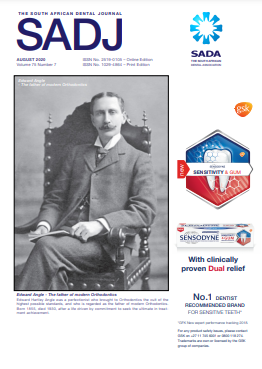Dental enamel
DOI:
https://doi.org/10.17159/2519-0105/2020/v75no7a6Keywords:
dental enamelAbstract
Dental enamel is the sparsest but most enduring component of all the tissues in the human body, yet contrarily contains the most detailed historiography of its development. Accordingly, analysis of enamels' chemistry, histology and pathology can reveal detailed ambient information of both fossilized, long-deceased and its contemporary milieu occurring during amelogenesis. In this respect, dental enamel is the most versatile exponent of its developmental mechanisms and acquisition of its complex form. Dental enamel is the ultimate lexicographer of lives lived.
Downloads
References
Ungar P. The Trouble with Teeth. Scientific American. 2020; 322(4); 44-9.
LeBlanc ARH, Apesteguia S. et al. Unique tooth morphology and prismatic enamel in Late Cretaceous Sphenodontians from Argentna. Current Biol. 2020; 30: 1755-61.
Johannes-Boyau R, et al. Elemental signatures of Australopithecus africanus reveals seasonal dietary stress. Nature 2019; 527: 112-5.
Bartlett JD, Simmer JP. New Perspectives on Amelotin and Amelogenesis. J Dent Res. 2015; 94(5): 642-5.
Ortiz A, Schander-Triplett K, et al. Enamel thickness variation in the deciduous dentition of extant large-bodied hominoids. Am J Phys Anthrop. 2020; doi: 10.1002/ajpa.24106.
Le Luyer M, Rottier S, Bayle P. Comparative patterns of enamel thickness topography and oblique molar wear in two early Neolithic and Medieval population samples. Am J Phys Anthrop. 2014; 155: 162-72.
Skinner MM, et al. Enamel thickness trends in Plio-Pleisto-cene hominin mandibular molars. J Hum Evol. 2015; 85: 35-45.
Welker F, et al. The dental proteome of Homo antecessor. Nature. 2020; Doi.org./19.1038/s 41586-020-2153-8.
Kono RT, et al. A 3-dimensional assessment of molar enamel thickness and distribution pattern in Gigantopithecus blacki. Quarterly International. 2014; 354: 46-51.
Wang WJ. New discoveries of Gigantopithecus blacki teeth from Chuifeng Cave in Bubing Basin, Guangxi, South China. J Hum Evol. 2009; 57: 229-40.
Pupa U et al. The Hardest Tissue. American Scientist 2020; 108: 14-5.
Beniash E, Stiffler CA, et al. The hidden structure of human enamel. Nature Communic. 2019; 10: 4383.
Kelly AM et al. Measuring the Microscopic Structure of Human Dental Enamel. J Pers Med. 2020; 10 (5): 1-17.
DeRocher, KA, Smeets PJM, Goodge PH et al. Chemical gradients in human enamel crystallites. Nature. 2020. 583: 66-71.
Elsharkaway S, Al-Jawad M. et al. Protein disorder-order interplay to guide the growth of hierarchical mineralized structures. Nature Communic. 2018; 9(1): doi: 10.1038/s1467-018-04319-0.
Lacruz RS, Habelitz S, Wright T, Paine ML. Dental enamel formation and implications for health and disease. Physiol Rev. 2017; 97: 939-93.
Sponheimer M, Lee-Thorp JA. Isotopic evidence for the diet of an early hominid Australopithecus africanus. Science. 1999; 283: 368-70.
Guatelli-Steinberg D. Macroscopic and microscopic analyses of linear enamel hypoplasia in Plio-Pleistocene South African hominins with respect to aspects of enamel development and morphology. Am J Phys Anthrop. 2003; 120: 309-22.
Vennila V, Madhu V, et al. Tetracycline-induced discoloration of deciduous teeth: Case series. J Internat. Oral Health. 2014; 6(3): 115-9.
Sanchez AR, Rogers III MD, Sheridan PJ. Tetracycline and other tetracycline-derivative staining of the teeth and oral cavity. Int J Dermatol. 2004; 43(10): 709-15.
Downloads
Published
Issue
Section
License
Copyright (c) 2021 Geoffrey H Sperber

This work is licensed under a Creative Commons Attribution-NonCommercial 4.0 International License.





.png)